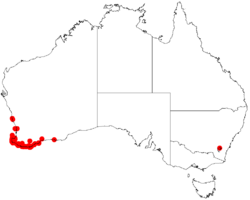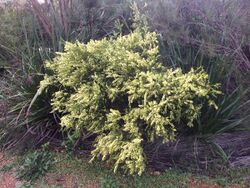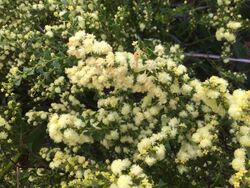Biology:Acacia littorea
| Shark tooth wattle | |
|---|---|

| |
| A. littorea flowers and foliage | |
| Scientific classification | |
| Kingdom: | Plantae |
| Clade: | Tracheophytes |
| Clade: | Angiosperms |
| Clade: | Eudicots |
| Clade: | Rosids |
| Order: | Fabales |
| Family: | Fabaceae |
| Subfamily: | Caesalpinioideae |
| Clade: | Mimosoid clade |
| Genus: | Acacia |
| Species: | A. littorea
|
| Binomial name | |
| Acacia littorea Maslin
| |

| |
| Occurrence data from AVH | |
Acacia littorea, also known as the shark tooth wattle,[1][2][3] is a shrub belonging to the genus Acacia and the subgenus Phyllodineae.
Description
The dense pungent shrub typically grows to a height of 0.5 to 3.0 metres (1.6 to 9.8 ft) and produces yellow flowers from August to November.[4] It has glabrous but prominently ribbed branchlets. The green, pungent and somewhat crowded phyllodes are ascending on the branchlets. They have an interesting obtriangular to obdeltate shape resembling a sharks tooth. The phyllodes are 7 to 17 millimetres (0.28 to 0.67 in) long and 5 to 15 mm (0.20 to 0.59 in) and sometimes larger. The simple inflorescences have globular heads containing 8 to 15 pale-yellow flowers. After flowering blackish to yellowish linear to curved seed pods that are around 6 centimetres (2.4 in) in length with a width of 2.5 to 3 mm (0.10 to 0.12 in). The pods contain shiny brown oblong seeds arranged longitudinally which are 2.5 to 3 mm (0.10 to 0.12 in) long.[5]
Taxonomy
The species was first formally described by the botanist Bruce Maslin in 1978 as part of the work Studies in the genus Acacia (Mimosaceae) – 8 A revision of the Uninerves – Triangulares, in part (the tetramerous species) published in the journal Nuytsia.[6]
The type specimen was collected by Bruce Maslin along the shoreline of Princess Royal Harbour near Albany in 1975.[5]
Several synonyms exist: Acacia dolabriformis, Acacia trapezoides, Acacia cuneata var. glabra, Acacia decipiens var. triangularis, Mimosa decipiens and Acacia praemorsa.[6]
The species is closely related to Acacia truncata.[5]
Distribution
It is native to an area in the South West, Great Southern and Peel regions of Western Australia.[4] The bulk of the population is found from Busselton east to Bremer Bay. An isolated population is found on Rottnest Island.[5] A. littorea grows mostly on coastal dunes in deep sandy soils and in limestone area.[4] It is commonly found in heath land communities and can be a dominant species.[5]
Cultivation
A. littorea is commercially available in seed form[7] or as tubestock.[8] It prefers a sunny position and well-drained soils and suits a coastal garden. The species is drought- and frost-tolerant. It is fast-growing but short-lived and suitable for erosion control or as a windbreak.[1]
See also
References
- ↑ 1.0 1.1 "Acacia littorea – Wattle". Gardening with Angus. https://www.gardeningwithangus.com.au/acacia-littorea-wattle/. Retrieved 22 August 2018.
- ↑ Peter Llewellyn (2018). "Acacia littorea Shark's-tooth Wattle". UK Wildflowers. http://www.ukwildflowers.com/Web_pages/acacia_littorea_sharks_tooth_wattle.htm. Retrieved 22 August 2018.
- ↑ "Survey for the Western Ringtail Possum Pseudocheirus occidentalis within part of Lots 3000 and 1523, Emu Point Drive, Albany, Western Australia.". Green Iguana. August 2007. https://www.landcorp.com.au/Documents/Projects/Regional%20South/Emu%20Point/Emupoint_westernringtailpossum_survey_000807.pdf. Retrieved 22 August 2018.
- ↑ 4.0 4.1 4.2 "Acacia littorea". FloraBase. Western Australian Government Department of Parks and Wildlife. https://florabase.dpaw.wa.gov.au/browse/profile/3424.
- ↑ 5.0 5.1 5.2 5.3 5.4 "Acacia littorea". World Wide Wattle. Western Australian Herbarium. http://worldwidewattle.com/speciesgallery/littorea.php. Retrieved 23 August 2018.
- ↑ 6.0 6.1 "Acacia littorea Maslin". Atlas of Living Australia. Global Biodiversity Information Facility. https://bie.ala.org.au/species/http://id.biodiversity.org.au/node/apni/2914671#names. Retrieved 23 August 2018.
- ↑ "Acacia littorea". Australian Seed. https://australianseed.com/shop/item/acacia-littorea-. Retrieved 23 August 2018.
- ↑ "Acacia littoera". The Tube Nursery. https://tubenursery.com.au/cape-collection/acacia-littorea/. Retrieved 23 August 2018.
Wikidata ☰ Q9566426 entry
 |



